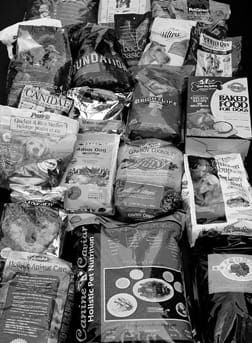There are basically two main camps in the dog food manufacturing business. The overwhelming majority of the industry belongs in one camp; not surprisingly, we’re fans of the other.
Let’s call the first group Camp A, as in A vitamin is a vitamin is a vitamin. These are the people who think that it doesn’t matter what ingredients a dog food contains, as long as the end result contains the recommended daily amounts of vitamins, minerals, and major nutrients (protein and fat) needed by dogs.
The goal of nutritionists and feed formulators in Camp A is to manufacture a palatable product that contains at least as much total nutrition as required by law for the least amount of money. Camp A Dog Food has to be tasty enough to appeal to dogs palates (if dogs won’t eat it, it won’t sell); it has to meet the nutrient profiles established by the Association of American Feed Control Officials (AAFCO, an advisory body that crafts model legislation for states to enact); and it has to be as profitable for its maker as possible.
Here’s a fact that makes denizens of Camp A very happy: They can use practically anything as an ingredient in Camp A Dog Food that is, anything that is generally recognized as safe (GRAS) for dogs.
So duh! They can’t use poison, any substances known to cause injury to dogs, ingredients that contain harmful levels of pesticides, or feed that has been contaminated with filth.
But they can use all sorts of low-cost by-products of the human food or food animal feed manufacturing industry, such as chicken by-products (chicken heads, feet, and guts), brewers rice (small fragments of rice kernels that have been separated from the larger kernels of milled rice), or corn gluten meal (the dried residue from corn after the removal of the larger part of the starch and germ, and the separation of the bran by the process employed in the manufacture of corn starch or syrup).
Each of these ingredients (and many other by-products) cost little when compared to their original forms (in this case, chicken, rice, and corn), and yet they still can be mixed with other ingredients to make up a complete and balanced dog food.
How can that be?
First, all dry dog foods are formulated with a vitamin/mineral premix that ensures the final product contains at least the minimum amounts of the vitamins and minerals deemed necessary (the AAFCO nutrient profiles) to maintain dogs in certain demographics (maintenance or growth and reproduction). That’s because the cooking process (whether it’s an extruded or baked food) pretty much destroys all the vitamins present in the food ingredients, and because (with a couple of exceptions) the ingredients lack the minerals dogs need.
As far as the macronutrients (protein and fat) are concerned, there are any number of ways that a dog food maker can reach the target levels of these nutrients. The most profitable method is to mix large amounts of inexpensive proteins and fats with small amounts of high-quality, energy-dense proteins and fats.
Youll note that we didn’t mention carbohydrates. While it’s hard for many people to believe, given that the vast majority of us have fed carb-loaded kibble to our dogs all our lives, dogs have no carbohydrate requirements. Studies have proven that a dog can get along just fine on a diet that contains zero carbs. Kibble is loaded with carbs because a) dogs can utilize them as a source of energy; b) carbs can facilitate absorption of other nutrients in the gut; c) when you are making a food that only needs to be about 18 percent protein and 8 percent fat, you need a lot of other stuff to flesh out the formula, and d) carbs are inexpensive (relative to fat and protein).
Plus, as it turns out, if a food mixture that contains more than about 45 percent animal products goes through an extruder (the kibble-making machine), the machine literally gums up and grinds to a halt.
B is for better
Contrast all that with this:
Ingredient quality, not cost, is of utmost importance to Camp B dog food makers. Camp B manufacturers aim to produce the highest-quality food they can, and they have set their prices accordingly. These are the people who pay top dollar for chicken from companies who will guarantee that no long-dead birds get into the processing plant. Who buy premium low-ash lamb from New Zealand, and grass-fed beef from organic ranchers. Who develop long-term relationships with growers who produce the best crops consistently.
These people are happy when consumers ask them for proof of the quality of their ingredients, or for tours of their plants.
Also, nutritionists in this camp feel certain that foods are more than the sum of their vitamin, mineral, fat, and protein contents. Even though neither the FDA nor AAFCO has studied and proven it yet, Camp B Dog Food formulators believe there are beneficial substances in whole, high-quality foods that are not yet fully recognized or understood. These include enzymes, probiotics, prebiotics, and even antibodies (found in colostrum and eggs).
Phytochemicals (chemicals found in plants) are another huge class of substances that scientists are just now learning about. Many powerful antioxidants have been found in plants, such as lycopene (in tomatoes and cranberries), polyphenols (green tea), limonene (citrus), flavonoids (pycnog-enol, grapeseed, green tea, cayenne), and curcumin (tumeric). Other herbs, fruits, vegetables, and spices are yielding substances with anticancer properties, such as allylic sulfides (garlic), capsaicin (cayenne), and carotenoids (vitamin A precursors found in yellow, orange, and dark green fruits and veggies).
Camp B nutritionists also intuit that there are beneficial interactions between whole foods synergies we don’t yet understand.
Come over to our camp
What proof do we have that Camp B Dog Food is any better than Camp A’s? We’ve seen the results ourselves, and so have our readers. Upgrade your dog’s food, and, if you’re paying close attention, you’ll notice many improvements. He stops licking his feet. His ear infections go away and don’t return. His anal glands don’t require squeezing. His eyes clear up and his coat gets thicker and shinier. His behavior might even improve. Doesn’t all that seem worth a trip to Camp B?
If so, check out the list of B-type foods on our approved foods list, or, using the same selection criteria we used to choose the foods on our list, evaluate your favorite dog food.
Also With This Article
Click here to view “Your Dog’s Diet: A Dry Food Discussion”
Click here to view “WDJ’s Approved Dry Food List”






